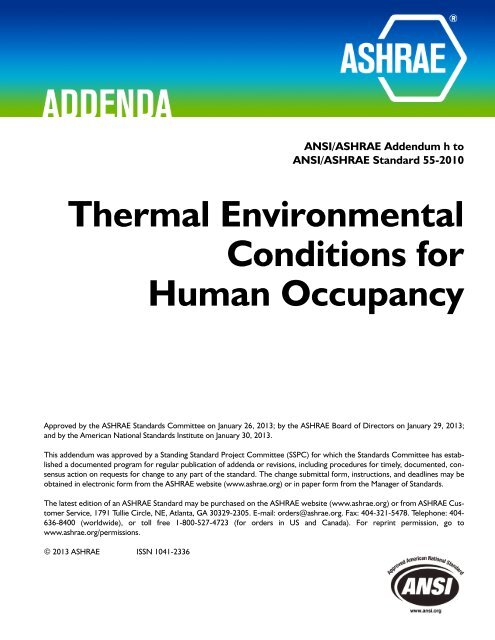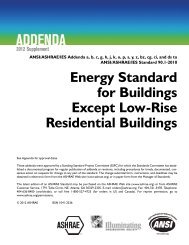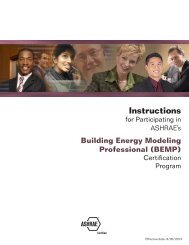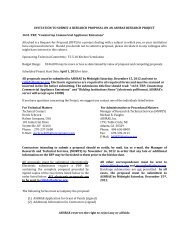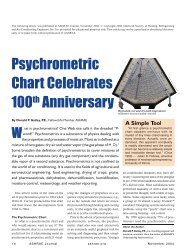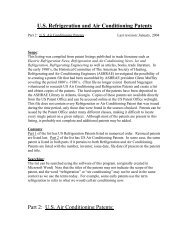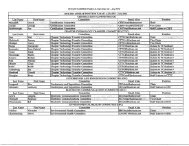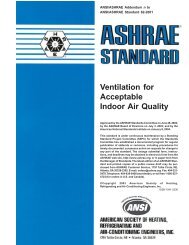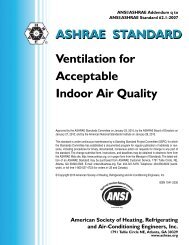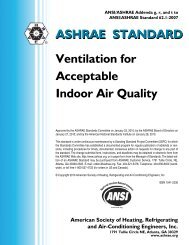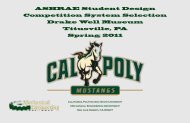Addendum h to Standard 55-2010 - ashrae
Addendum h to Standard 55-2010 - ashrae
Addendum h to Standard 55-2010 - ashrae
You also want an ePaper? Increase the reach of your titles
YUMPU automatically turns print PDFs into web optimized ePapers that Google loves.
ANSI/ASHRAE <strong>Addendum</strong> h <strong>to</strong><br />
ANSI/ASHRAE <strong>Standard</strong> <strong>55</strong>-<strong>2010</strong><br />
Thermal Environmental<br />
Conditions for<br />
Human Occupancy<br />
Approved by the ASHRAE <strong>Standard</strong>s Committee on January 26, 2013; by the ASHRAE Board of Direc<strong>to</strong>rs on January 29, 2013;<br />
and by the American National <strong>Standard</strong>s Institute on January 30, 2013.<br />
This addendum was approved by a Standing <strong>Standard</strong> Project Committee (SSPC) for which the <strong>Standard</strong>s Committee has established<br />
a documented program for regular publication of addenda or revisions, including procedures for timely, documented, consensus<br />
action on requests for change <strong>to</strong> any part of the standard. The change submittal form, instructions, and deadlines may be<br />
obtained in electronic form from the ASHRAE website (www.<strong>ashrae</strong>.org) or in paper form from the Manager of <strong>Standard</strong>s.<br />
The latest edition of an ASHRAE <strong>Standard</strong> may be purchased on the ASHRAE website (www.<strong>ashrae</strong>.org) or from ASHRAE Cus<strong>to</strong>mer<br />
Service, 1791 Tullie Circle, NE, Atlanta, GA 30329-2305. E-mail: orders@<strong>ashrae</strong>.org. Fax: 404-321-5478. Telephone: 404-<br />
636-8400 (worldwide), or <strong>to</strong>ll free 1-800-527-4723 (for orders in US and Canada). For reprint permission, go <strong>to</strong><br />
www.<strong>ashrae</strong>.org/permissions.<br />
© 2013 ASHRAE ISSN 1041-2336
© ASHRAE (www.<strong>ashrae</strong>.org). For personal use only. Additional reproduction, distribution, or<br />
transmission in either print or digital form is not permitted without ASHRAE's prior written permission.<br />
ASHRAE Standing <strong>Standard</strong> Project Committee <strong>55</strong><br />
Cognizant TC: TC 2.1, Physiology and Human Environment<br />
SPLS Liaison: Steven F. Bruning<br />
Gwelen Paliaga, Chair* Gail S. Brager Brian M. Lynch<br />
Lawrence J. Schoen, Vice Chair* Richard de Dear Michael P. O’Rourke*<br />
Sahar Abbaszadeh Fard, Secretary* Josh Eddy* Abhijeet Pande*<br />
Peter F. Alspach* Thomas B. Hartman* Julian Rimmer*<br />
Edward A. Arens* Daniel Int-Hout, III* Stefano Schiavon<br />
Richard M. Aynsley* Michael A. Humphreys Peter Simmonds*<br />
Robert Bean* Essam Eldin Khalil* John L. S<strong>to</strong>ops*<br />
Atze Boerstra Baizhan Li Stephen C. Turner*<br />
*Denotes members of voting status when the document was approved for publication<br />
ASHRAE STANDARDS COMMITTEE 2012–2013<br />
Kenneth W. Cooper, Chair Julie M. Ferguson Janice C. Peterson<br />
William F. Walter, Vice-Chair Krishnan Gowri Heather L. Platt<br />
Douglass S. Abramson Cecily M. Grzywacz Ira G. Pos<strong>to</strong>n<br />
Karim Amrane Richard L. Hall Douglas T. Reindl<br />
Charles S. Barnaby Rita M. Harrold James R. Tauby<br />
Hoy R. Bohanon, Jr. Adam W. Hinge James K. Vallort<br />
Steven F. Bruning Debra H. Kennoy Craig P. Wray<br />
David R. Conover Jay A. Kohler Charles H. Culp, III, BOD ExO<br />
Steven J. Emmerich Rick A. Larson<br />
Mark P. Modera<br />
Stephanie C. Reiniche, Manager of <strong>Standard</strong>s<br />
Constantinos A. Balaras, CO<br />
SPECIAL NOTE<br />
This American National <strong>Standard</strong> (ANS) is a national voluntary consensus standard developed under the auspices of ASHRAE.<br />
Consensus is defined by the American National <strong>Standard</strong>s Institute (ANSI), of which ASHRAE is a member and which has approved this<br />
standard as an ANS, as “substantial agreement reached by directly and materially affected interest categories. This signifies the concurrence<br />
of more than a simple majority, but not necessarily unanimity. Consensus requires that all views and objections be considered, and that an<br />
effort be made <strong>to</strong>ward their resolution.” Compliance with this standard is voluntary until and unless a legal jurisdiction makes compliance<br />
manda<strong>to</strong>ry through legislation.<br />
ASHRAE obtains consensus through participation of its national and international members, associated societies, and public review.<br />
ASHRAE <strong>Standard</strong>s are prepared by a Project Committee appointed specifically for the purpose of writing the <strong>Standard</strong>. The Project<br />
Committee Chair and Vice-Chair must be members of ASHRAE; while other committee members may or may not be ASHRAE members, all<br />
must be technically qualified in the subject area of the <strong>Standard</strong>. Every effort is made <strong>to</strong> balance the concerned interests on all Project<br />
Committees.<br />
The Manager of <strong>Standard</strong>s of ASHRAE should be contacted for:<br />
a. interpretation of the contents of this <strong>Standard</strong>,<br />
b. participation in the next review of the <strong>Standard</strong>,<br />
c. offering constructive criticism for improving the <strong>Standard</strong>, or<br />
d. permission <strong>to</strong> reprint portions of the <strong>Standard</strong>.<br />
DISCLAIMER<br />
ASHRAE uses its best efforts <strong>to</strong> promulgate <strong>Standard</strong>s and Guidelines for the benefit of the public in light of available information and<br />
accepted industry practices. However, ASHRAE does not guarantee, certify, or assure the safety or performance of any products, components,<br />
or systems tested, installed, or operated in accordance with ASHRAE’s <strong>Standard</strong>s or Guidelines or that any tests conducted under its<br />
<strong>Standard</strong>s or Guidelines will be nonhazardous or free from risk.<br />
ASHRAE INDUSTRIAL ADVERTISING POLICY ON STANDARDS<br />
ASHRAE <strong>Standard</strong>s and Guidelines are established <strong>to</strong> assist industry and the public by offering a uniform method of testing for rating<br />
purposes, by suggesting safe practices in designing and installing equipment, by providing proper definitions of this equipment, and by providing<br />
other information that may serve <strong>to</strong> guide the industry. The creation of ASHRAE <strong>Standard</strong>s and Guidelines is determined by the need for them,<br />
and conformance <strong>to</strong> them is completely voluntary.<br />
In referring <strong>to</strong> this <strong>Standard</strong> or Guideline and in marking of equipment and in advertising, no claim shall be made, either stated or implied,<br />
that the product has been approved by ASHRAE.<br />
ASHRAE is a registered trademark of the American Society of Heating, Refrigerating and Air-Conditioning Engineers, Inc.<br />
ANSI is a registered trademark of the American National <strong>Standard</strong>s Institute.
© ASHRAE (www.<strong>ashrae</strong>.org). For personal use only. Additional reproduction, distribution, or<br />
transmission in either print or digital form is not permitted without ASHRAE's prior written permission.<br />
(This foreword is not part of this standard. It is merely<br />
informative and does not contain requirements necessary<br />
for conformance <strong>to</strong> the standard. It has not been<br />
processed according <strong>to</strong> the ANSI requirements for a<br />
standard and may contain material that has not been<br />
subject <strong>to</strong> public review or a consensus process.<br />
Unresolved objec<strong>to</strong>rs on informative material are not<br />
offered the right <strong>to</strong> appeal at ASHRAE or ANSI.)<br />
FOREWORD<br />
This addendum clarifies the normative requirements for<br />
determining clothing insulation for representative occupants<br />
and moves these normative requirements <strong>to</strong> the body of the<br />
<strong>Standard</strong>. It adds a new informative appendix containing<br />
similar material that was in the previous Normative Appendix<br />
B, Clothing Insulation.<br />
Note: In this addendum, changes <strong>to</strong> the current standard<br />
are indicated in the text by underlining (for additions) and<br />
strikethrough (for deletions) unless the instructions specifically<br />
mention some other means of indicating the changes.<br />
<strong>Addendum</strong> h <strong>to</strong> <strong>Standard</strong> <strong>55</strong>-<strong>2010</strong><br />
Add the following new Section 5.2.2 and relocate Tables B1,<br />
B2, and B3 from Normative Appendix B as shown.<br />
5.2.2 Clothing Insulation<br />
5.2.2.1 Insulation for Each Representative Occupant<br />
5.2.2.1.1 For each representative occupant, determine<br />
the clothing insulation in clo (Icl ).<br />
5.2.2.1.2 Insulation of several occupants with significantly<br />
different ensembles shall not be averaged <strong>to</strong> find a single,<br />
average insulation value.<br />
Exception: Where individuals are free <strong>to</strong> adjust clothing <strong>to</strong><br />
account for individual differences in response <strong>to</strong> the<br />
thermal environment, it is permitted <strong>to</strong> use a single representative<br />
occupant with an average clothing insulation<br />
value for multiple individuals.<br />
5.2.2.2 Insulation Determination. Use one or a combination<br />
of the following methods <strong>to</strong> determine clothing insulation.<br />
a. The data presented in Table 5.2.2.2A for the expected<br />
ensemble of each representative occupant.<br />
b. Add or subtract the insulation (I clu) of individual garments<br />
in Table 5.2.2.2B from the ensembles in Table<br />
5.2.2.2A <strong>to</strong> determine the insulation of ensembles not<br />
listed.<br />
c. Determine a complete clothing ensemble using the sum<br />
of the individual values listed for each item of clothing<br />
in the ensemble in Table 5.2.2.2B.<br />
d. It is permitted, but not required, <strong>to</strong> adjust any of the<br />
above methods for seated occupants using Table<br />
5.2.2.2C.<br />
e. For moving occupants it is permitted, but not required,<br />
<strong>to</strong> adjust any of the above methods using the following<br />
formula:<br />
I cl, active = I cl × (0.6 + 0.4 / M)<br />
1.2 met < M < 2.0 met<br />
where M is the metabolic rate in met units and I cl is the<br />
insulation without movement.<br />
f. Interpolate between or extrapolate from the values given<br />
in Tables 5.2.2.2B and 5.2.2.2C.<br />
g. Use measurement with thermal manikins or other<br />
approved engineering methods.<br />
5.2.2.3 Limits of Applicability<br />
5.2.2.3.1 High Insulation Value. This standard does<br />
not apply <strong>to</strong> occupants whose clothing insulation exceeds<br />
1.5 clo.<br />
5.2.2.3.2 Moisture-Impermeable Clothing. This<br />
standard does not apply <strong>to</strong> occupants whose clothing is highly<br />
impermeable <strong>to</strong> moisture transport (e.g., chemical protective<br />
clothing or rain gear).<br />
5.2.2.3.3 Sleeping Occupants. This standard does<br />
not apply <strong>to</strong> occupants who are sleeping, reclining in contact<br />
with bedding, or able <strong>to</strong> adjust blankets or bedding.<br />
ANSI/ASHRAE <strong>Addendum</strong> h <strong>to</strong> ANSI/ASHRAE <strong>Standard</strong> <strong>55</strong>-<strong>2010</strong> 1
© ASHRAE (www.<strong>ashrae</strong>.org). For personal use only. Additional reproduction, distribution, or<br />
transmission in either print or digital form is not permitted without ASHRAE's prior written permission.<br />
TABLE B1 5.2.2.2A Clothing Insulation Values for Typical Ensembles a<br />
Clothing Description Garments Included b*<br />
Trousers 1) Trousers, short-sleeve shirt 0.57<br />
I cl (clo)<br />
2) Trousers, long-sleeve shirt 0.61<br />
3) #2 plus suit jacket 0.96<br />
4) #2 plus suit jacket, vest, T-shirt 1.14<br />
5) #2 plus long-sleeve sweater, T-shirt 1.01<br />
6) #5 plus suit jacket, long underwear bot<strong>to</strong>ms 1.30<br />
Skirts/Dresses 7) Knee-length skirt, short-sleeve shirt (sandals) 0.54<br />
8) Knee-length skirt, long-sleeve shirt, full slip 0.67<br />
9) Knee-length skirt, long-sleeve shirt, half slip, long-sleeve sweater 1.10<br />
10) Knee-length skirt, long-sleeve shirt, half slip, suit jacket 1.04<br />
11) Ankle-length skirt, long-sleeve shirt, suit jacket 1.10<br />
Shorts 12) Walking shorts, short-sleeve shirt 0.36<br />
Overalls/Coveralls 13) Long-sleeve coveralls, T-shirt 0.72<br />
14) Overalls, long-sleeve shirt, T-shirt 0.89<br />
15) Insulated coveralls, long-sleeve thermal underwear <strong>to</strong>ps and bot<strong>to</strong>ms 1.37<br />
Athletic 16) Sweat pants, long-sleeve sweatshirt 0.74<br />
Sleepwear 17) Long-sleeve pajama <strong>to</strong>ps, long pajama trousers, short 3/4 length robe (slippers, no socks) 0.96<br />
a Data are from Chapter 9 in the 2009 ASHRAE Handbook – Fundamentals.3<br />
b* All clothing ensembles, except where otherwise indicated in parentheses, include shoes, socks, and briefs or panties. All skirt/dress clothing ensembles include panty hose and<br />
no additional socks.<br />
2 ANSI/ASHRAE <strong>Addendum</strong> h <strong>to</strong> ANSI/ASHRAE <strong>Standard</strong> <strong>55</strong>-<strong>2010</strong>
© ASHRAE (www.<strong>ashrae</strong>.org). For personal use only. Additional reproduction, distribution, or<br />
transmission in either print or digital form is not permitted without ASHRAE's prior written permission.<br />
Garment Description ba<br />
TABLE B2 5.2.2.2B Garment Insulation a<br />
I clu(clo) Garment Description ba<br />
Underwear Dress and Skirts cb<br />
Bra 0.01 Skirt (thin) 0.14<br />
Panties 0.03 Skirt (thick) 0.23<br />
Men’s briefs 0.04 Sleeveless, scoop neck (thin) 0.23<br />
T-shirt 0.08 Sleeveless, scoop neck (thick), i.e., jumper 0.27<br />
Half-slip 0.14 Short-sleeve shirtdress (thin) 0.29<br />
Long underwear bot<strong>to</strong>ms 0.15 Long-sleeve shirtdress (thin) 0.33<br />
Full slip 0.16 Long-sleeve shirtdress (thick) 0.47<br />
Long underwear <strong>to</strong>p 0.20 Sweaters<br />
Footwear Sleeveless vest (thin) 0.13<br />
Ankle-length athletic socks 0.02 Sleeveless vest (thick) 0.22<br />
Panty hose/s<strong>to</strong>ckings 0.02 Long-sleeve (thin) 0.25<br />
Sandals/thongs 0.02 Long-sleeve (thick) 0.36<br />
Shoes 0.02 Suit Jackets and Vests dc<br />
Slippers (quilted, pile lined) 0.03 Sleeveless vest (thin) 0.10<br />
Calf-length socks 0.03 Sleeveless vest (thick) 0.17<br />
Knee socks (thick) 0.06 Single-breasted (thin) 0.36<br />
Boots 0.10 Single-breasted (thick) 0.44<br />
Shirts and Blouses Double-breasted (thin) 0.42<br />
Sleeveless/scoop-neck blouse 0.12 Double-breasted (thick) 0.48<br />
Short-sleeve knit sport shirt 0.17 Sleepwear and Robes<br />
Short-sleeve dress shirt 0.19 Sleeveless short gown (thin) 0.18<br />
Long-sleeve dress shirt 0.25 Sleeveless long gown (thin) 0.20<br />
Long-sleeve flannel shirt 0.34 Short-sleeve hospital gown 0.31<br />
Long-sleeve sweatshirt 0.34 Short-sleeve short robe (thin) 0.34<br />
Trousers and Coveralls Short-sleeve pajamas (thin) 0.42<br />
Short shorts 0.06 Long-sleeve long gown (thick) 0.46<br />
Walking shorts 0.08 Long-sleeve short wrap robe (thick) 0.48<br />
Straight trousers (thin) 0.15 Long-sleeve pajamas (thick) 0.57<br />
Straight trousers (thick) 0.24 Long-sleeve long wrap robe (thick) 0.69<br />
Sweatpants 0.28<br />
Overalls 0.30<br />
Coveralls 0.49<br />
I clu(clo)<br />
a Data are from Chapter 9 in the 2009 ASHRAE Handbook – Fundamentals.3<br />
ba “Thin” refers <strong>to</strong> garments made of lightweight, thin fabrics often worn in the summer; “thick” refers <strong>to</strong> garments made of heavyweight, thick fabrics often worn in the winter.<br />
cb Knee-length dresses and skirts.<br />
dc Lined vests.<br />
ANSI/ASHRAE <strong>Addendum</strong> h <strong>to</strong> ANSI/ASHRAE <strong>Standard</strong> <strong>55</strong>-<strong>2010</strong> 3
© ASHRAE (www.<strong>ashrae</strong>.org). For personal use only. Additional reproduction, distribution, or<br />
transmission in either print or digital form is not permitted without ASHRAE's prior written permission.<br />
TABLE B3 5.2.2.2C Typical Added Insulation when Sitting on a Chair<br />
(Valid for Applicable <strong>to</strong> Clothing Ensembles with Standing Insulation Values of 0.5 clo < I cl < 1.2 clo)<br />
Net chair a<br />
(This appendix is not part of this standard. It is merely<br />
informative and does not contain requirements necessary<br />
for conformance <strong>to</strong> the standard. It has not been<br />
processed according <strong>to</strong> the ANSI requirements for a<br />
standard and may contain material that has not been<br />
subject <strong>to</strong> public review or a consensus process.<br />
Unresolved objec<strong>to</strong>rs on informative material are not<br />
offered the right <strong>to</strong> appeal at ASHRAE or ANSI.)<br />
INFORMATIVE APPENDIX B—<br />
CLOTHING INSULATION<br />
The amount of thermal insulation worn by a person has a<br />
substantial impact on thermal comfort and is an important<br />
variable in applying this standard. Clothing insulation is<br />
expressed in a number of ways. In this standard, the clothing<br />
insulation of an ensemble expressed as a clo value (I cl) is used.<br />
Users not familiar with clothing insulation terminology are<br />
referred <strong>to</strong> Chapter 9 of the 2009 ASHRAE Handbook—<br />
Fundamentals 3 for more information.<br />
The insulation provided by clothing can be determined by<br />
a variety of means, and if accurate data are available from<br />
other sources, such as measurement with thermal manikins,<br />
these data are acceptable for use. When such information is not<br />
available, the tables in this standard may be used <strong>to</strong> estimate<br />
clothing insulation using one of the methods described below.<br />
Regardless of the source of the clothing insulation value, this<br />
standard is not intended for use with clothing ensembles with<br />
more than 1.5 clo of insulation. This standard is not intended<br />
for use when occupants wear clothing that is highly impermeable<br />
<strong>to</strong> moisture transport (e.g., chemical protective clothing<br />
or rain gear).<br />
Three methods for estimating clothing insulation are<br />
presented. The methods are listed in order of accuracy. The<br />
tables used in the standard are derived from Chapter 9 of the<br />
2009 ASHRAE Handbook—Fundamentals. 3<br />
Method 1: Table 5.2.2.2A of this standard lists the insulation<br />
provided by a variety of common clothing ensembles.<br />
If the ensemble in question matches reasonably<br />
well with one of the ensembles in this table, then the<br />
indicated value of I cl should be used.<br />
0.00 clo<br />
Metal chair 0.00 clo<br />
Wooden side arm chair b<br />
0.00 clo<br />
Wooden s<strong>to</strong>ol +0.01 clo<br />
<strong>Standard</strong> office chair +0.10 clo<br />
Executive chair +0.15 clo<br />
a A chair constructed from thin, widely spaced cords that provide no thermal insulation.<br />
b Note: this chair was used in most of the basic studies of thermal comfort that were used <strong>to</strong> establish the PMV-PPD index.<br />
Delete the existing Normative Appendix B and add the following new Informative Appendix B.<br />
Method 2: Table 5.2.2.2B of this standard presents the<br />
thermal insulation of a variety of individual garments. It<br />
is acceptable <strong>to</strong> add or subtract these garments from the<br />
ensembles in Table 5.2.2.2A <strong>to</strong> estimate the insulation<br />
of ensembles that differ in garment composition from<br />
those in Table 5.2.2.2A. For example, if long underwear<br />
bot<strong>to</strong>ms are added <strong>to</strong> Ensemble 5 in Table 5.2.2.2A, the<br />
insulation of the resulting ensemble is estimated as<br />
I cl = 1.01 + 0.15 = 1.16 clo<br />
Method 3: It is acceptable <strong>to</strong> define a complete clothing<br />
ensemble using a combination of the garments listed in<br />
Table 5.2.2.2B of this standard. The insulation of the<br />
ensemble is estimated as the sum of the individual values<br />
listed in Table 5.2.2.2B. For example, the estimated<br />
insulation of an ensemble consisting of overalls worn<br />
with a flannel shirt, T-shirt, briefs, boots, and calf-length<br />
socks is<br />
I cl = 0.30 + 0.34 + 0.08 + 0.04 + 0.10 + 0.03 = 0.89 clo<br />
Tables 5.2.2.2A and 5.2.2.2B are for a standing person. A<br />
sitting posture results in a decreased thermal insulation due <strong>to</strong><br />
compression of air layers in the clothing. This decrease can be<br />
offset by insulation provided by the chair. Table 5.2.2.2C<br />
shows the net effect on clothing insulation for typical indoor<br />
clothing ensembles that result from sitting in a chair. These<br />
data may be used <strong>to</strong> adjust clothing insulation calculated using<br />
any of the above methods. For example, the clothing insulation<br />
for a person wearing Ensemble 3 from Table 5.2.2.2A and<br />
sitting in an executive chair is 0.96 + 0.15 = 1.11 clo. For many<br />
chairs, the net effect of sitting is a minimal change in clothing<br />
insulation. For this reason, no adjustment <strong>to</strong> clothing insulation<br />
is needed if there is uncertainty as <strong>to</strong> the type of chair and/<br />
or if the activity for an individual includes both sitting and<br />
standing.<br />
Tables 5.2.2.2A and 5.2.2.2B are for a person that is not<br />
moving. Body motion decreases the insulation of a clothing<br />
ensemble by pumping air through clothing openings and/or<br />
causing air motion within the clothing. This effect varies<br />
considerably depending on the nature of the motion (e.g.,<br />
walking versus lifting) and the nature of the clothing (stretch-<br />
4 ANSI/ASHRAE <strong>Addendum</strong> h <strong>to</strong> ANSI/ASHRAE <strong>Standard</strong> <strong>55</strong>-<strong>2010</strong>
© ASHRAE (www.<strong>ashrae</strong>.org). For personal use only. Additional reproduction, distribution, or<br />
transmission in either print or digital form is not permitted without ASHRAE's prior written permission.<br />
able and snug fitting versus stiff and loose fitting). Because of<br />
this variability, accurate estimates of clothing insulation for an<br />
active person are not available unless measurements are made<br />
for the specific clothing under the conditions in question (e.g.,<br />
with a walking manikin). An approximation of the clothing<br />
insulation for an active person is<br />
I cl, active = I cl × (0.6 + 0.4 / M)<br />
1.2 met < M < 2.0 met<br />
where M is the metabolic rate in met units and I cl is the insulation<br />
without activity. For metabolic rates less than or equal<br />
<strong>to</strong> 1.2 met, no adjustment for motion is required.<br />
When a person is sleeping or resting in a reclining<br />
posture, the bed and bedding provide considerable thermal<br />
insulation. It is not possible <strong>to</strong> determine the thermal insulation<br />
for most sleeping or resting situations unless the individual<br />
is immobile. Individuals adjust bedding <strong>to</strong> suit individual<br />
preferences. Provided adequate bedding materials are available,<br />
the thermal environmental conditions desired for sleeping<br />
and resting vary considerably from person <strong>to</strong> person and<br />
cannot be determined by the methods included in this standard.<br />
Clothing variability among occupants in a space is an<br />
important consideration in applying this standard. This variability<br />
takes two forms. In the first form, different individuals<br />
wear different clothing due <strong>to</strong> fac<strong>to</strong>rs unrelated <strong>to</strong> the thermal<br />
conditions. Examples include different clothing style prefer-<br />
ences for men and women and offices where managers are<br />
expected <strong>to</strong> wear suits while other staff members may work in<br />
shirtsleeves. In the second form, the variability results from<br />
adaptation <strong>to</strong> individual differences in response <strong>to</strong> the thermal<br />
environment. For example, some individuals wear sweaters<br />
while others wear short-sleeve shirts in the same environment<br />
if there are no constraints limiting what is worn. The first form<br />
of variability results in differences in the requirements for<br />
thermal comfort between the different occupants, and these<br />
differences should be addressed in applying this standard. In<br />
this situation, it is not correct <strong>to</strong> determine the average clothing<br />
insulation of various groups of occupants <strong>to</strong> determine the<br />
thermal environmental conditions needed for all occupants.<br />
Where the variability within a group of occupants is of the<br />
second form and is a result only of individuals freely making<br />
adjustments in clothing <strong>to</strong> suit their individual thermal preferences,<br />
it is correct <strong>to</strong> use a single representative average clothing<br />
insulation value for everyone in that group.<br />
For near-sedentary activities where the metabolic rate is<br />
approximately 1.2 met, the effect of changing clothing insulation<br />
on the optimum operative temperature is approximately<br />
6°C (11°F) per clo.<br />
Example: Table 5.2.2.2B indicates that adding a thin,<br />
long-sleeve sweater <strong>to</strong> a clothing ensemble increases<br />
clothing insulation by approximately 0.25 clo. Adding<br />
this insulation would lower the optimum operative temperature<br />
by approximately 6°C/clo × 0.25 clo = 1.5°C<br />
(11°F/clo × 0.25 clo = 2.8°F).<br />
ANSI/ASHRAE <strong>Addendum</strong> h <strong>to</strong> ANSI/ASHRAE <strong>Standard</strong> <strong>55</strong>-<strong>2010</strong> 5
© ASHRAE (www.<strong>ashrae</strong>.org). For personal use only. Additional reproduction, distribution, or<br />
transmission in either print or digital form is not permitted without ASHRAE's prior written permission.<br />
POLICY STATEMENT DEFINING ASHRAE’S CONCERN<br />
FOR THE ENVIRONMENTAL IMPACT OF ITS ACTIVITIES<br />
ASHRAE is concerned with the impact of its members’ activities on both the indoor and outdoor environment. ASHRAE’s<br />
members will strive <strong>to</strong> minimize any possible deleterious effect on the indoor and outdoor environment of the systems and<br />
components in their responsibility while maximizing the beneficial effects these systems provide, consistent with accepted<br />
standards and the practical state of the art.<br />
ASHRAE’s short-range goal is <strong>to</strong> ensure that the systems and components within its scope do not impact the indoor and<br />
outdoor environment <strong>to</strong> a greater extent than specified by the standards and guidelines as established by itself and other<br />
responsible bodies.<br />
As an ongoing goal, ASHRAE will, through its <strong>Standard</strong>s Committee and extensive technical committee structure,<br />
continue <strong>to</strong> generate up-<strong>to</strong>-date standards and guidelines where appropriate and adopt, recommend, and promote those new<br />
and revised standards developed by other responsible organizations.<br />
Through its Handbook, appropriate chapters will contain up-<strong>to</strong>-date standards and design considerations as the material is<br />
systematically revised.<br />
ASHRAE will take the lead with respect <strong>to</strong> dissemination of environmental information of its primary interest and will seek<br />
out and disseminate information from other responsible organizations that is pertinent, as guides <strong>to</strong> updating standards and<br />
guidelines.<br />
The effects of the design and selection of equipment and systems will be considered within the scope of the system’s<br />
intended use and expected misuse. The disposal of hazardous materials, if any, will also be considered.<br />
ASHRAE’s primary concern for environmental impact will be at the site where equipment within ASHRAE’s scope<br />
operates. However, energy source selection and the possible environmental impact due <strong>to</strong> the energy source and energy<br />
transportation will be considered where possible. Recommendations concerning energy source selection should be made by<br />
its members.
2/13<br />
ASHRAE · 1791 Tullie Circle NE · Atlanta, GA 30329 · www.<strong>ashrae</strong>.org


